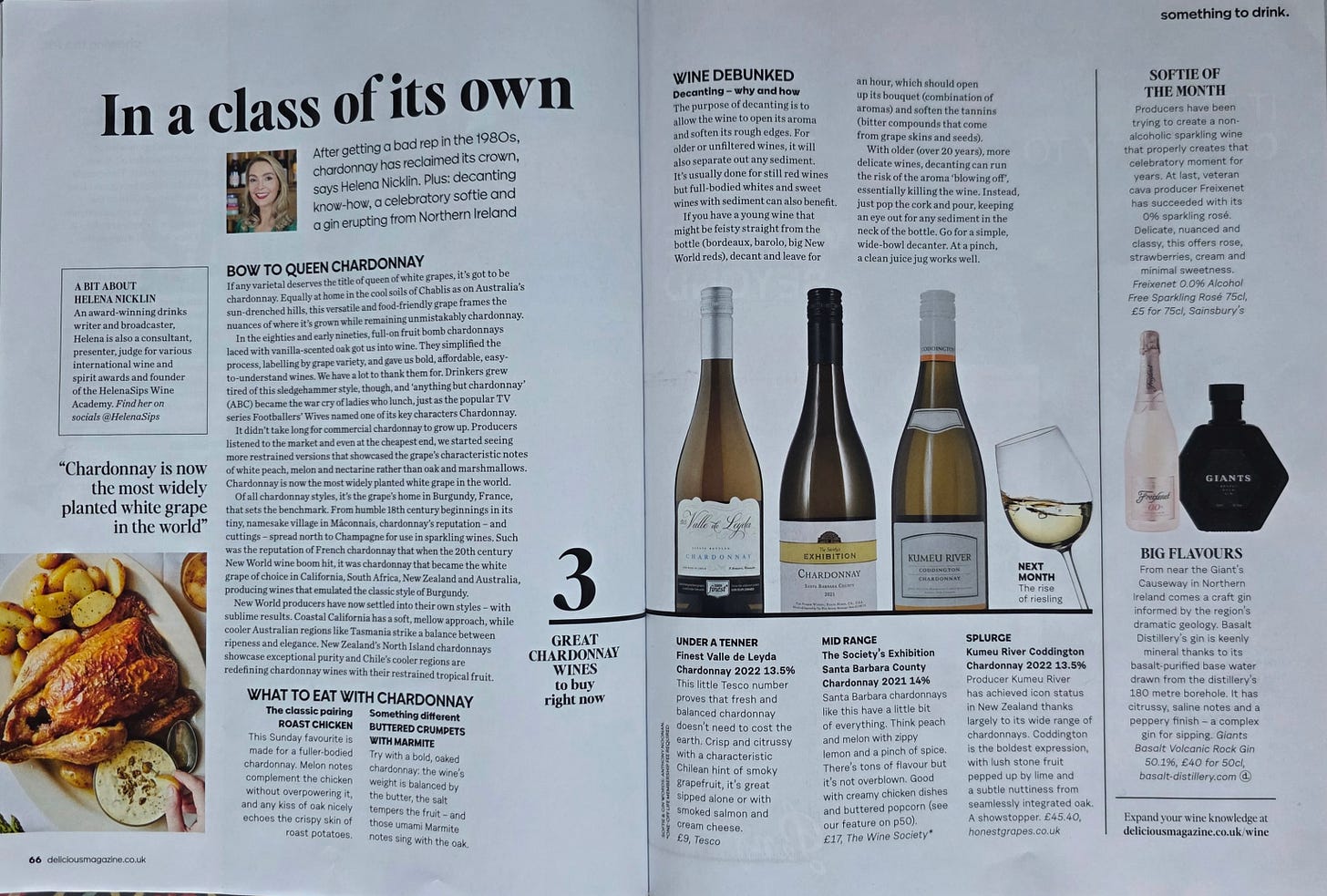A Love Letter to Chardonnay in Delicious Magazine (April 2025 Issue)
If any varietal deserves the title of Queen of Wine Grapes, it’s Chardonnay. Equally at home in the cool, chalky soils of Chablis as on the sun-drenched hills of Australia, it’s a supremely versatile and food friendly grape with a unique ability to frame the nuances of where it's grown while remaining unmistakably Chardonnay. Many of us, however, still find ourselves flinching at its name.
Back in the eighties and early nineties, outrageously full-on, fruit bomb Chardonnays laced with vanilla-scented oak got us into wine. They simplified the process, labelling by grape variety rather than region and gave us bold, easy to understand wines that were affordable. We have a lot to thank them for. Predictably though, drinkers grew tired of this sledgehammer style and ‘Anything but Chardonnay’ became the war cry of ladies who lunch, just as the major TV series Footballers Wives named one of its key characters ‘Chardonnay’. The die was cast. Even I still hear the grape in an Essex accent all these years later.
It didn’t take long however, for commercial Chardonnay like this to grow up. Producers listened to the market and even at the cheapest end, we quickly started seeing more restrained versions that showcased the grape’s characteristic notes of white peach, melon and nectarine rather than oak and marshmallows - like a supermodel who finally gets to take all that makeup off. It is now officially the most widely planted white grape in the world. But how did it get there?
A Bit of History
Of all the Chardonnay styles globally, it is the grape’s original home in Burgundy, France, that sets the benchmark. From humble beginnings in its tiny, namesake village within the Mâconnais area in the 18th century, Chardonnay’s reputation - and cuttings - spread north to Champagne for use in sparkling wines. Clearly, that went rather well. Such was the reputation of French Chardonnay that by the 20th Century when the New World wine boom hit, it was Chardonnay that became the white grape of choice, setting up home across California, South Africa, New Zealand and Australia particularly.
It was in these sunnier climes that Chardonnay developed its bold new personality with all those in-your-face flavours. As winemaking and tastes evolved however, producers made a point of creating more ‘Burgundian’ Chardonnays that were less cloying and more complex and savoury, often with deeper, incense-like spice from French oak barrels rather than the candied, vanilla notes of American wood chippings. They planted closer to the sea and at high altitudes to keep the vines cool and produce more elegant wines and in doing so, they safeguarded Chardonnay’s legacy.
Regional Expressions
Emulating Burgundy down to its specific village expressions is what winemakers globally attempted for years. From the mineral Puligny-Montrachet style to the fabulously fleshy whites of Meursault and if unoaked, wines were ‘Chablis-esque’. But today, Chardonnay is evolving again. These newer wine regions are now finding their own way, dropping the French references and leaning into what makes their own ‘terroir’, i.e. the combination of soil, topography and practices so deliciously unique.
Coastal California for example, has developed its own soft, mellow style, while cooler climate Australian regions like Tasmania are striking the balance between ripeness and elegance. New Zealand’s north island Chardonnays showcase exceptional purity and Chile’s cooler regions are redefining Chardonnay with their restrained, tropical fruit. Don’t forget; where you have still Chardonnay, you often have traditional method sparkling too, giving Champagne a real run for its money. Here in England for example, Chardonnay is at the heart of our thriving wine industry, producing world class sparkling and still wines with a distinctly English character.
You could never get bored of this shape-shifting grape, such is the range of styles it offers. Even the buttery style is back in places; it just now wears a corset.
Food Pairing
Roast chicken with gravy and roasties are a classic pairing for a fuller-bodied Chardonnay. The ripe, melon fruit complements the chicken without overpowering it and any kiss of oak nicely mirrors the crispy skin and salty potatoes.
For something a bit different, toasted crumpets with lashings of butter and marmite love a bold, oaked Chardonnay. The wine weight is balanced by the butter, the salt tempers the fruit and those umami marmite notes sing with the oak. Netflix and chill night, sorted!
Tesco Finest Valley Leyda 2022, 75cl, 13.5% £8.50 Tesco
This little Tesco number shows that beautiful, fresh and balanced Chardonnay doesn't need to cost the earth. Crisp and citrusy with a characteristic, Chilean hint of smoky grapefruit, this is great sipped alone but would love some smoked salmon and cream cheese too.
The Society's Exhibition Santa Barbara County Chardonnay 2021, £17 The Wine Society
Santa Barbara Chardonnays like this one have a little bit of everything but with the lightest touch. Think peach and melon with zippy, lemon cream and a pinch of baking spice. There’s tons of flavour but it's not overblown. Gorgeous with creamy chicken and buttered popcorn.
Kumeu River, Coddington Chardonnay, 2022 £45 Lea & Sandeman
Producer Kumeu River has achieved icon status in New Zealand thanks largely to their wide range of Chardonnays. Coddington is their boldest expression, with lush, stone fruit pepped up by zesty lime and a subtle nuttiness from seamlessly integrated oak. A showstopper.



